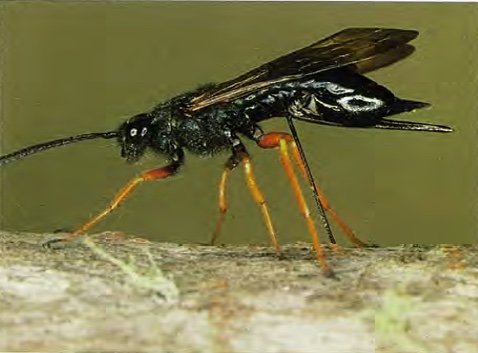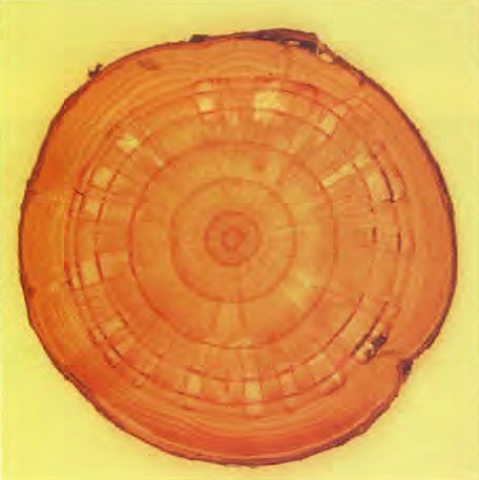PESTS AND DISEASES OF FORESTRY IN NEW ZEALAND
Amoylostereum areolatum vectored by Sirex noctilio
Scion is the leading provider of forest-related knowledge in New Zealand
Formerly known as the Forest Research Institute, Scion has been a leader in research relating to forest health for over 50 years. The Rotorua-based Crown Research Institute continues to provide science that will protect all forests from damage caused by insect pests, pathogens and weeds. The information presented below arises from these research activities.
From Scion publication Forest Research Bulletin 220.
An Introduction to The Diseases of Forest and Amenity Trees in New Zealand
G.S.Ridley and M.A. Dick 2001
(See also Sirex woodwasp, Forest and Timber Insects in New Zealand No. 20)
Species: Amylostereum areolatum (Basidiomycete)
Common name: Sirex attack
Country of origin: Europe
Host(s): Abies sp., Larix decidua, L. kaempferi, Picea abies, P. sitchensis, Pinus contorta, P. echinata, P. elliottii, P. muricata, P. nigra subsp. nigra, P. nigra subsp. laricio, P. palustris, P. patula, P. pinaster, P. ponderosa, P. radiata, P. strobus, P. sylvestris, P. taeda, and Pseudotsuga menziesii.
Symptoms: Resin bleeding from insect drill holes; wilting of young needles and the yellowing of old needles; foliage turns red and eventually falls; mortality becomes evident in spring; trees killed in previous years will show Sirex noctilio emergence holes varying from 3 to 6.6 mm.
Disease development: The female S. noctilio (Fig. 69) transports the fungus, Amylostereum areolatum, in special organs. These organs contain spores mixed with a mucus-like substance. The female finds a suitable tree and drills holes through the bark and into the xylem with its ovipositor. If only one hole is drilled, it will contain only mucus and fungus. If multiple holes are drilled, they will contain one or more eggs with a few fungal spores. But the last hole drilled will contain only mucus and fungus.

Upon hatching, the larvae feed on the fungus-infested wood and the final size and health of the larvae are dependent on the success of the fungus in decomposing the wood (Fig. 70). Female larvae pick up the fungus, which they carry through pupation and into adulthood, thus ensuring the continuation of the fungus.
Amylostereum areolatum benefits from this relationship in that S. noctilio disperse it, transport it to new food sources, and carry it past the tree's defences. Sirex noctilio gains from A. areolatum converting wood to a suitable food for its larvae and conditioning the tree for optimal larval development. The relationship is detrimental to S. noctilio as the fungus releases volatile compounds that attract egg and larval parasitoids and it provides an ideal food source for the parasitic nematode Beddingia siricidicola.

The tree's defences include high resin flow which reduces wasp attack, high resin content which reduces fungal growth, and high moisture content which reduces larval survival. The tree's defences are overcome by the S. noctilio mucus which causes a hypersensitive reaction and results in localised death of infected tissue. Volatiles released by injured or stressed trees attract further wasps. The tree responds by accumulating monoterpenes and polyphenols around the drill holes and these intoxicate the eggs and larvae, and inhibit fungal growth. They also disrupt the ray parenchyma and disrupt further advance of the fungus.
The interaction between S. noctilio and A. areolatum overcomes the tree's resistance. Sirex noctilio mucus injected into the tree causes increased stem respiration, reduces bark starch, and reduces phloem activity, thus making conditions more suitable for the fungus. The fungus then invades the sapwood, reduces the water supply to the crown, and reduces local wood moisture content. When it reaches 60-70% this is ideal for larval tunnelling.
The interaction between S. noctilio and A. areolatum is responsive to the tree's physiology. Sirex noctilio responds to relatively healthy phloem by drilling only one hole, which contains mucus and fungus. The effect of the fungus and mucus reduces osmotic pressure in the phloem, thus increasing the tree's stress. Wasps respond by creating drills with multiple tunnels containing an increasing number of eggs. This increases larval survival by incorporating the host's physiology into the insect's reproductive behaviour.
NZ distribution: Found throughout New Zealand.
Economic impact and control: The wood wasp S. noctilio was accidentally introduced into New Zealand sometime before 1900. In the 1920s it was associated with pine deaths in the Rotorua/Taupo area. Concern at the time brought about the introduction of the parasitoid Rhyssa persuasoria, which was established by the early 1930s.
The Depression, followed by labour shortages during World War II, prevented any forest thinning operations during this time. Drought in 1946 seriously affected the 120 000 ha of plantations, all planted between 1927 and 1934, on the pumice lands of the central North Island. Many trees became stressed, creating an ideal breeding ground for S. noctilio, and its populations exploded. There are accounts of S. noctilio flying around trees like swarms of bees and tree trunks white with resin oozing from the insect drill holes. By 1949 the S. noctilio build-up had caused serious mortality and an estimate of damage ranged from 20% to 33% of the total P. radiata stock. Mortality was highest in the faster-growing more heavily stocked areas, and comparatively light in areas with harsher climates that resulted in slow-growing and understocked plantations. The disease tended to take out suppressed and malformed trees, and so in fact provided a "beneficial thinning". However, incremental growth was lost in dominant trees. Mortality was so severe in some forests (for example, Rotoehu Forest) that planting of P. radiata was suspended altogether. At this time the R. persuasoria population was built up artificially and Ibalia leucospoides was introduced to attempt to control the S. noctilio. During the 1950s the S. noctilio population declined because of the biological thinning induced by the wasp and because of changed silvicultural practices (a market for thinnings had developed and light-weight chainsaws had become available). Also, the parasitoid Rhyssa lineolata had accidentally been introduced and this had spread, and Megarhyssa nortoni had been intentionally introduced as a biocontrol agent. Then, in 1962 a parasitic nematode of S. noctilio, Beddingia siricidicola, was discovered and was deliberately introduced into areas not previously infected, such as the South Island.
References: Gilmour 1965; Raffa & Klepzig 1992; Zondag & Nuttall 1977.
This information is intended for general interest only. It is not intended to be a substitute for specific specialist advice on any matter and should not be relied on for that purpose. Scion will not be liable for any direct, indirect, incidental, special, consequential or exemplary damages, loss of profits, or any other intangible losses that result from using the information provided on this site.
(Scion is the trading name of the New Zealand Forest Research Institute Limited.)



